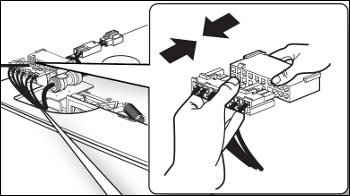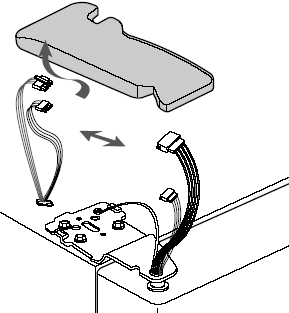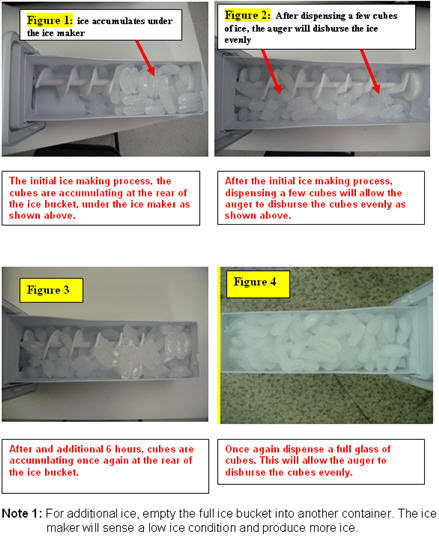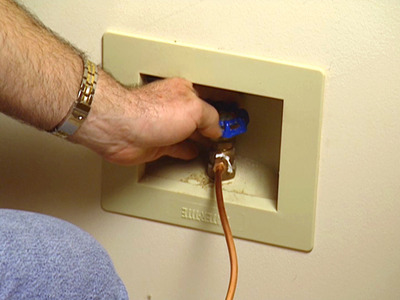|
PROBLEMS COVERED:
- Not Dispensing Ice
- No Ice After the Doors Were Removed Recently
- How Much Ice Should my Ice Maker Produce?
- Low Ice Production and Maximizing Ice Production
- Too Much Ice
PROBLEM 1:
Not Dispensing Ice
SOLUTION 1A:
Turn On or Reset Ice Maker
If your ice maker is not creating ice, it's possible that it has been turned off. To fix this problem, please perform the following:
- Look at your fridge's control panel. Most fridge have an Ice Off icon that lights up when the ice maker is off. If the icon is on, it means no ice is being made. Touch the icon to disable the Ice Off function.
- Once the ice maker turns on, please wait at least 24 hours for ice production to get back to normal.
If the ice maker is still not making ice, you can try resetting it. To do this, please perform the following:
- Press and hold the ice maker test/reset button for 3 seconds.
- Please wait another 24 hours for ice production to get back to normal.
Solution 1B: Check Child Lock
- Please check if Child Lock is enabled on your fridge. This could be preventing the ice from dispensing.
- If Child Lock is on, please turn it off and try to dispense ice again.

Solution 1C: Check State of Ice
If not Child Lock is disabled on your fridge, excessive ice could be causing the problem. Please try the following:
- Please press the dispenser lever, and check if you can hear the operating sound of the auger motor.
- If you can hear the motor operating, please check the state of the ice.
- If ice is stuck together, it could be blocking more ice from dispensing. Please discard any blockages inside the ice bucket and try dispensing ice again.
*If you cannot hear the auger motor, or if ice still does not dispense after blockages have been removed, then service is needed.
Solution 1D: Check the Water Pressure
Your ice maker may not be creating ice if the water pressure is too low. To measure the amount of pressure, please perform the following:
- Dispense water into a measuring cup for a full 10 seconds. Your fridge should dispense at least 6 ounces (3/4 cup) or more.
- If no water dispenses at all, check that the water line is connected.
- If you get less than 6 ounces (3/4 cup), your water pressure is too low. A potential cause might be a clogged water filter, so remove your water filter and try again.
- If the problem is still not fixed, the water pressure is definitely too low and will need to be increased. Water pressure is not controlled by the refrigerator, so you will need to be adjust the pressure at the source.
Solution 1E: Check The Connector
If your refrigerator was recently installed, and ice will not dispense, please perform the following:
- Please check the connector at the top of your fridge's left-side door. The connector may appear to be properly connected, but in fact it is not.
- To access the connector, please remove the cover on the top of the refrigerator.
- To check the connector for proper installation, please push both halves together. Then, try and pull the connector apart.
- If the connector is properly installed, it will not come apart when you pull on both sides.
- If the connector comes apart, please contact the installer, so they can properly install it.

PROBLEM 2:
No Ice After the Doors Were Removed Recently
SOLUTION 2: Check Door Wiring
If ice is not dispensing after the doors were recently removed, please perform the following:
- Please check the wiring on the left door's hinge. There are two sets of wires- one to power the digital display and another to connect the display to the ice maker. If the ice maker wire is not reconnected, the freezer will not produce ice.
- Please reconnect any wires that are loose. If you are unsure about how to do this, please consult your user manual or call the installer.

PROBLEM 3: How Much Ice Should My Ice Maker Produce?
SOLUTION 3:
Average Ice Production
- Our refrigerators have 2 types of ice-makers: one that can produce 8 cubes (flex tray) every cycle, and one that can produce 9 cubes (heated tray) every cycle. The ice-maker can make a new batch of ice (either 8 or 9 cubes) about every 90 minutes.
- Based on this, it's possible for your fridge to make between 100 and 140 ice cubes per day, though it may vary slightly depending on different conditions.
- Ice production in your fridge can vary based on several factors including - but not limited to - the set temperature of their freezer, how often their doors are opened, and whether or not the ice in their bucket is evenly distributed.
PROBLEM 4:
Low Ice Production and Maximizing Ice Production
SOLUTION 4A:
Initial Ice Making Process And Ice Refilling Process
- The more ice you dispense, the more ice your fridge will make. It is normal for your ice maker to shut off when there is a lot of ice in the ice bucket.
- The ice maker will typically make a batch of ice every 90 minutes until it is full, although this may vary based on several factors, such as how often the doors are opened.
- During your fridge's ice making process, the ice cubes accumulate at the rear of the ice bucket, making a pile [see Figure 1 below]. The Ice Level sensor "sees" the pile of ice and stops production because it thinks an adequate amount of ice has been made. If you do not dispense or use the ice, the ice maker will remain off.

- After you have dispensed or used some of the ice, the auger in the ice bucket will distribute the remaining ice cubes evenly throughout the ice bucket [see Figure 2 above]. The ice maker will sense a low ice level and will resume the ice making process.
- If you are worried about the ice piling up, please harvest some ice cubes periodically, approximately 2-3 cubes every few hours. This will help spread ice throughout the bucket, so the ice maker will not turn off.
- You can also distribute the ice in your ice bucket using a ladle or spatula, so the ice maker will sense a low ice level and begin creating more ice.
SOLUTION 4B: Maximizing Ice Production
If you want to maximize the ice production in your fridge, please try the following:
- Please make sure that the water line is connected and that the water valve is fully open.

- Please check that your water source is turned on and that you have adequate water pressure. (Read the instructions from Solution 1D above for steps.)
- Check the water filter. Over time the water filter can become clogged and prevent water from being supplied to the ice maker. (Read instructions from Solution 4D below for steps.)
- For your refrigerator to dispense ice, your fridge doors must be closed and the ice maker selector should be set on Cubed or Crushed.
- Please minimize how long you keep the freezer door open.
- Please make sure your freezer's temperature is turned down below -18C (0F) to help with freezing.
- If your refrigerator has freezing features, press the Power Freeze button or the Super Speed button to speed up the ice making process. In the Power Freeze mode, the ice making interval is reduced from 90 minutes to 55 minutes. If the ice bucket fills in less than 10 hours, Power Freeze will stop automatically.
- If your home had a power outage that lasted longer than 4 hours, it may take up to 24 hours for the fridge to reach its regular cooling temperature and begin producing ice again.
- Please check that the connector and the wiring on the left-side door are not loose.
- Make sure the refrigerator is leveled correctly. Improper leveling can cause many issues with refrigerators.
NOTE
If you need additional ice, empty the full ice bucket into another container. The ice maker will sense a low ice condition and produce more ice.
Solution 4C: Brand New Fridges
If your fridge is brand new, please let your refrigerator cool for 24 hours before you dispense any ice.
- After 24 hours have passed, please dispense a few ice cubes. The auger will distribute the remaining ice cubes evenly through out the ice bucket. The ice maker will sense a low ice condition and will resume the ice making process.
- Please wait an additional 6 hours, and then dispense a few ice cubes again. The auger will again distribute the ice cubes evenly through out the ice bucket. From this point on, ice production will start whenever the ice maker senses a low ice level.
Solution 4D: Check The Water Filter
- Please make sure the water filter isn't partially clogged.
- To test the water filter, please remove the filter. (Please remember that any water dispensed or ice produced during this period will not be filtered by the refrigerator.)
- If ice production increases, then reinsert the water filter to see if the water filter was a cause of the issue. If ice production slows again, this means your water filter is partially clogged and should be replaced.
- If ice production does not reach a normal level within 24 hours after the filter has been removed, the water filter can be reinserted and continue to be used. However, to fix the ice problem, your unit will require service.*
NOTE
RFG298*** requires a water filter bypass cap in order for water to flow through the unit when the water filter is removed.
PROBLEM 5:
Too Much Ice
SOLUTION 5: Service
*If your ice maker is making too much ice, your refrigerator requires service. ��������������������������������������������������������������������������������������������������������������������������������������������������������������������������������������������������������������������������������������������������������������������������������������������������������������������������������������������������������������������������������������������������������������������������������������������������������������������������������������������������������������������������������������������������������������������������������������������������
|
